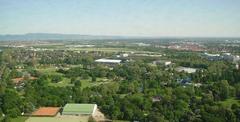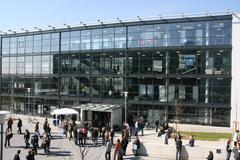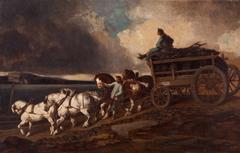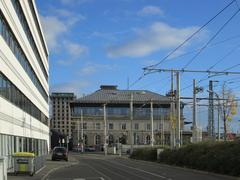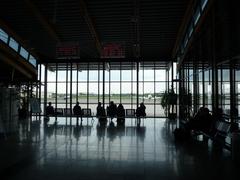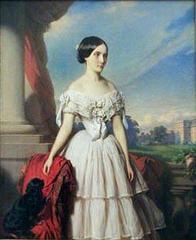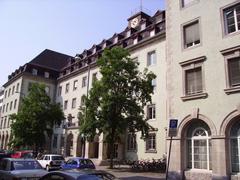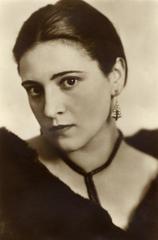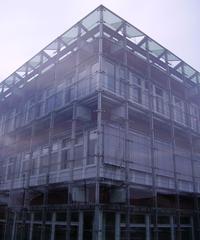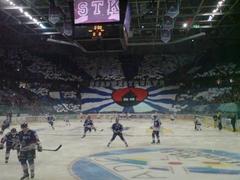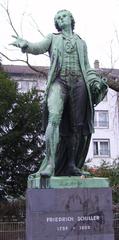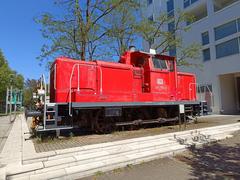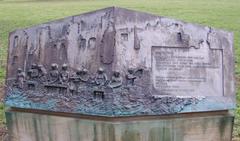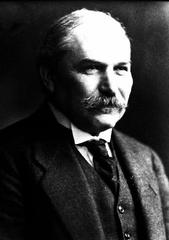Zeitgeschichtliches Museum Mannheim: Visiting Hours, Tickets, and Historical Sites Guide
Date: 14/06/2025
Introduction
The Zeitgeschichtliches Museum Mannheim (ZGMA) serves as a vital gateway into Mannheim’s multifaceted 20th- and 21st-century history. Centrally located at Friedrichsplatz, the museum offers a compelling exploration of the city’s evolution—from its industrial prominence and the trauma of the Nazi era to postwar reconstruction and the challenges of modern urban life. Founded in 1995 by local historians, civic leaders, and survivors, ZGMA is both a repository of historical artifacts and a hub for education, remembrance, and reflection (Stadt Mannheim).
With thoughtfully curated exhibitions, accessible facilities, and a strong educational focus, the museum welcomes everyone from history enthusiasts to casual visitors. This guide provides comprehensive information on visiting hours, ticketing, highlights of the permanent and temporary exhibitions, accessibility, and nearby historical sites to help you plan a meaningful visit.
Table of Contents
- Introduction
- Origins and Mission
- Historical Context: Mannheim in the 20th Century
- Permanent and Temporary Exhibitions
- Museum Architecture and Location
- Visiting Hours, Tickets, and Access
- Educational Programs and Community Engagement
- Facilities and Visitor Services
- Nearby Historical Sites
- Practical Tips for Visitors
- Frequently Asked Questions (FAQ)
- Conclusion and Call to Action
- References and Further Reading
Origins and Mission
Established in 1995, the Zeitgeschichtliches Museum Mannheim was envisioned as a dedicated space to document the city’s turbulent modern past. The museum’s core mission is to collect, preserve, and interpret artifacts, documents, and personal testimonies from pivotal eras, including the Weimar Republic, National Socialism, World War II, postwar reconstruction, the Cold War, and the contemporary period. ZGMA’s collections and programming also reflect Mannheim’s ongoing transformation during German reunification and European integration (Stadt Mannheim).
Historical Context: Mannheim in the 20th Century
Strategically positioned at the confluence of the Rhine and Neckar rivers, Mannheim emerged as a major industrial hub in early 20th-century Germany. Factories such as Benz & Cie. (later Mercedes-Benz) and John Deere placed the city at the heart of industrial innovation, but also made it a target during World War II—over 60% of Mannheim was destroyed in Allied bombings (Stadtarchiv Mannheim).
The Nazi period left a deep scar, with the persecution and deportation of the city’s Jewish community and other marginalized groups. The museum’s exhibitions respectfully document these tragedies and the resilience of survivors. After 1945, Mannheim’s rapid postwar recovery, known as the Wirtschaftswunder, was shaped by the integration of displaced persons, refugees, and migrant workers, creating the city’s diverse modern identity (Gedenkstättenportal).
Permanent and Temporary Exhibitions
Thematic Highlights
ZGMA’s exhibitions are organized both chronologically and thematically, providing a thorough understanding of Mannheim’s history:
- Weimar Republic and Rise of National Socialism: Original newspapers, election posters, and diaries illuminate the era’s political and social upheaval.
- Life Under the Third Reich: Displays of uniforms, ration cards, propaganda, and survivor testimonies document the impact on daily life and the persecution of minorities.
- War and Destruction: Artifacts such as bomb fragments and personal belongings recovered from ruins evoke the devastation of World War II.
- Postwar Reconstruction: Photographs, oral histories, and architectural plans highlight the rebuilding of the city and the role of “Trümmerfrauen” (rubble women).
- Migration and Integration: Testimonies and objects reflect the experiences of migrant workers and Mannheim’s growing multiculturalism.
- Cold War and Beyond: Exhibits on Mannheim’s garrison city status, protest movements, and the fall of the Berlin Wall (whichmuseum.com).
Community-Driven Projects
The museum regularly collaborates with schools, universities, and local organizations to produce participatory exhibitions and educational events. These initiatives foster community engagement and encourage the sharing of diverse perspectives (whichmuseum.com).
Museum Architecture and Location
Housed in a restored 19th-century industrial building near the iconic Wasserturm (Water Tower), the museum’s architecture blends original brickwork with modern glass extensions, symbolizing the dialogue between Mannheim’s past and present. The museum is centrally located at Friedrichsplatz 4, 68165 Mannheim, and is easily accessible via public transport and major roadways (Mannheim Tourismus).
Visiting Hours, Tickets, and Access
- Standard Visiting Hours: Tuesday to Sunday, 10:00 AM – 6:00 PM; closed Mondays and major public holidays. Some special exhibitions may extend these hours (official website).
- Admission Fees: Adults €8, reduced €5 (students, seniors 65+, people with disabilities), free for children under 12 with an adult, and special family tickets available.
- Tickets: Available on-site or via the museum’s ticketing portal.
- Accessibility: Fully wheelchair accessible; elevators, adapted restrooms, and wheelchairs provided on request.
- Public Transport: Tram lines 1, 2, 3, 6, and 9 (Wasserturm stop); 10-minute walk from Mannheim Hauptbahnhof (VRN public transport).
Educational Programs and Community Engagement
ZGMA is recognized for its active educational outreach, welcoming over 10,000 students annually. Programs range from guided tours in German and English to interactive workshops for schools and universities, exploring topics like everyday life during divided Germany and migration in Mannheim. The museum also hosts public lectures, commemorative events (e.g., Kristallnacht remembrance), and family-friendly workshops (Haus der Geschichte Baden-Württemberg).
Facilities and Visitor Services
- Café: Offers regional snacks and beverages with indoor/outdoor seating.
- Museum Shop: Sells books, educational games, postcards, and local souvenirs.
- Free Wi-Fi: Available throughout the museum; a mobile app provides self-guided tours (museum app download).
- Lockers and Cloakrooms: Free for visitor use.
- Sustainability: Energy-efficient lighting, recycling, and locally sourced café ingredients as part of the city’s “Green City Mannheim” initiative (Green City Mannheim).
Nearby Historical Sites
Augment your visit by exploring other significant Mannheim sites:
- Mannheim Palace: Baroque residence and university.
- Technoseum: Science and technology museum.
- Kunsthalle Mannheim: Modern and contemporary art.
- Luisenpark: One of Germany’s most beautiful urban parks. For more, consult the Mannheim Tourism Office.
Practical Tips for Visitors
- Best Times: Weekday mornings are quieter; weekends and school holidays are busier.
- Photography: Non-flash photography is permitted for personal use; commercial photography requires permission.
- Food and Drink: Only allowed in the café and designated areas.
- Luggage: Large bags must be stored in lockers.
- Lost and Found: Inquire at the information desk or use the online contact form.
Frequently Asked Questions (FAQ)
Q: What are the museum’s opening hours?
A: Tuesday–Sunday, 10:00 AM–6:00 PM. Closed Mondays and major holidays. Always check the current schedule before visiting.
Q: How much are tickets?
A: Adults €8, reduced €5, children under 12 free with an adult, and family/group tickets available (ticket prices).
Q: Is the museum accessible for visitors with disabilities?
A: Yes. Step-free access, elevators, accessible restrooms, and wheelchairs are available.
Q: Are guided tours available in English?
A: Yes, but English-language tours require at least one week’s advance booking (group booking).
Q: Can I take photographs inside the museum?
A: Yes, for personal use without flash. Commercial uses require prior approval.
Museum Philosophy and Ethical Approach
ZGMA’s motto, “Krieg gehört in das Museum” (“War belongs in the museum”), underscores its ethical commitment to presenting military history as a subject for critical reflection, not glorification (ZGMA official site). Exhibits are designed to encourage understanding and remembrance, avoiding sensationalism or political bias. The museum’s collections—ranging from airship artifacts and World War II memorabilia to oral histories—invite visitors to reflect on the complexities and consequences of war (Museen.de).
Summary and Final Recommendations
The Zeitgeschichtliches Museum Mannheim is a cornerstone of historical education and civic remembrance in the city. Its diverse exhibitions, authentic setting, and robust educational outreach offer a deeply immersive experience for all visitors. Extensive resources, from a mobile app to guided tours and interactive displays, ensure history is accessible and relevant. Whether you are planning a family outing, a research visit, or a group tour, ZGMA stands as one of Mannheim’s must-visit cultural landmarks.
For the latest information on exhibitions, events, and visiting logistics, be sure to check the official museum website, and consider downloading the Audiala app for enhanced guides and content.
References and Further Reading
- Stadt Mannheim
- whichmuseum.com
- ZGMA official site
- Museumspedia
- VRN public transport
- Mannheim Tourismus
- Museen.de
- Onlinestreet
- Green City Mannheim
- Haus der Geschichte Baden-Württemberg
